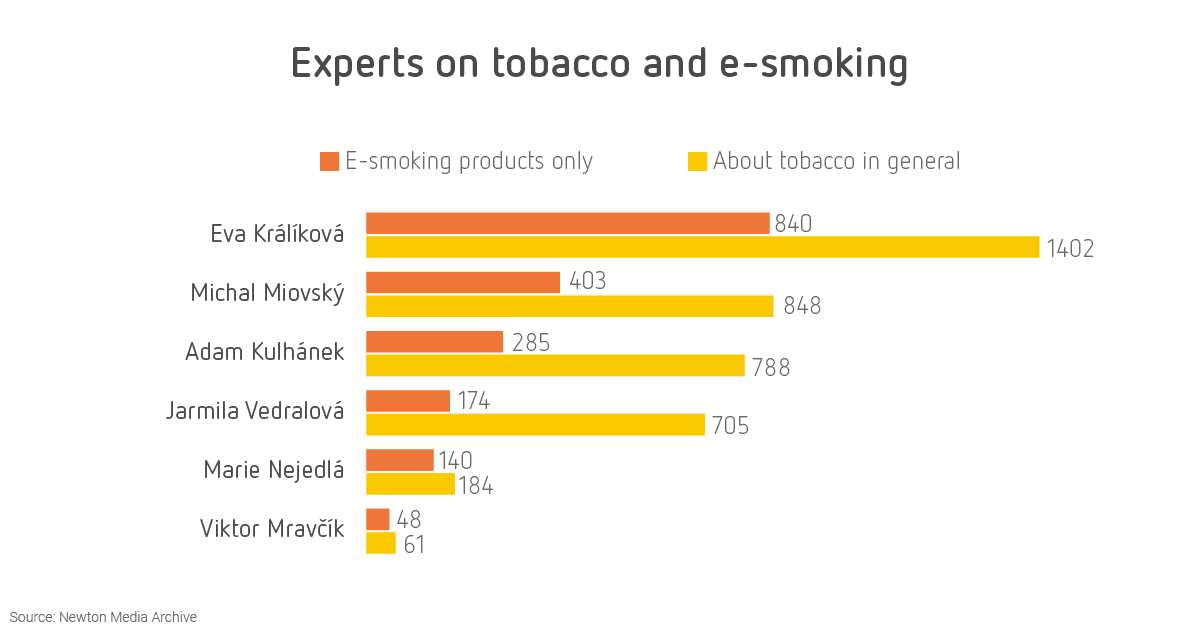Almost half of Czech smokers use tobacco heating devices or e-cigarettes, so-called vaporizers. As Newton Media’s media analysis shows, social media debaters are much stricter when it comes to the ratings of such devices than experts. While addictologists see the main potential of e-smoking products in the treatment of tobacco addiction, the lay public criticizes their smell.
According to a Nielsen Atmosphere survey from last year, almost a third (29 %) of Czechs smokes and 26 % of them uses tobacco heating devices and 17 % likes e-cigarettes. According to Newton Media’s media analysis, social media debaters are much stricter in their ratings than experts who comment on them in traditional media.
E-smoking smells and causes headaches vs. e-smokers are healthier and don’t smell
The main argumentation of users of e-smoking products is based on the perception of odour and the evaluation of their impact on health. The biggest problem for the opponents is the negative olfactory experience. With a few exceptions, however, they only blame the smell on heated tobacco. This comment concerns mainly the IQOS product, which completely overshadowed all tobacco heating devices and vaporizers in the media. Itcorresponds to its dominant position on the market. On the contrary, lawyers praise the elimination of odours, even on clothes or in the apartment. Some even highlighted the pleasant smell, which, however, concerned vaporizers and specific fillings for them rather than tobacco heating equipment.
For proponents, however, the issue of health came first. „In addition to subjective comments on improving respiration, there have been arguments taken over from experts pointing out that e-smoking products contain 95% fewer pollutants than conventional ones, and that is not nicotine, but carcinogenic combustion products what is harmful when smoking cigarettes,“ says Daniel Weidenhoffer from Newton Media. „The arguments of opponents of tobacco and e-cigarette heaters were similarly rational. They warned that this is a relatively new product, the harmfulness of which may manifest itself in the future, or that it does not matter if the smoker destroys his lungs with e-smoking products or a classic cigarette, „adds Weidenhoffer.
However, the threat to traditional cigarette manufacturers and their efforts to re-orient themselves to products based on tobacco heating or vaporizers are mainly posed by comments from the middle part of both argument pyramids. For opponents, it is a description of specific side effects (headaches, coughs, abdominal pain, scratching of the vocal cords, etc.) that can be more effective than subjective judgments about smell or odour than general descriptions of harmful effects that the user has heard since childhood. An even greater threat to manufacturers is the arguments of e-smoking advocates, who point out that thanks to tobacco heating devices or vaporizers, they have managed to reduce the consumption of traditional tobacco products, save money, and potentially even quit smoking. Lower or zero consumption of tobacco products is certainly a win for the smoker but not for the manufacturer.
Great topic for addictologists
In the media outlets of the most cited addictologists, the issue of e-smoking forms either a larger part of the „tobacco“ media coverage (Eva Králíková, Marie Nejedlá, Viktor Mravčík) or a substantial part of it (Michal Miovský, Adam Kulhánek, Jarmila Vedralová).

These experts agreed on the following premises: It is best not to smoke, e-smoking products are good for quitting, not for non-smokers, heated tobacco is better than burning tobacco, steaming is better than heated tobacco and e-smoking is useful, but doctor and tobacco companies are no allies.

Experts can be divided into two groups according to what they emphasize in their argumentation. According to the first group, anything that reduces the supply of harmful substances to the body means a benefit for addictology. They see the main difference between traditional smoking and e-smoking products in the fact that there is no burning and inhalation of carcinogenic products of paper and tobacco combustion. This group is relatively optimistic and assesses the issue in terms of the interest of patients who are trying to end their addiction or at least reduce its harmful effects. „These optimists include Professor Michal Miovský from the Department of Addictology of the First Medical Faculty of Charles University and the General Hospital, who expects smokeless tobacco to gradually push classic cigarettes completely out of the market and thus become a marginal phenomenon,“ says Daniel Weidenhoffer. We can also include the head of the National Monitoring Centre for Drugs and Addictions, Viktor Mravčík, according to whom tar is the biggest killer he mainly kills tar, so replacing classic cigarettes with electronic ones is certainly a positive step.“
On the contrary, the second group, with concerns about the future, is worried about the impact of e-smoking on the young generation. They see the danger of tobacco and e-cigarette heaters in the fact that they are easily accessible to all, including non-smoking youth, and that they pretend to be a healthy alternative to conventional cigarettes, and we will not be able to evaluate their health effects until a longer period has passed. Adam Kulhánek from the Department of Addictology of the 1st Medical Faculty of Charles University and the General Hospital summarized the concerns of this group. He points out that e-smoking products are more attractive to young people than traditional tobacco products, they perceive them as a status symbol they want to share with their peers. The way from occasional use to addiction is very short when it comes to nicotine in any form. Professor Eva Králíková from the Centre for Tobacco Addicts of the 3rd Internal Clinic of the 1st Faculty of Medicine at Charles University and the General Hospital completed the bleak picture from the future as she perceives the actions of tobacco companies with suspicion. According to her, they need to address the young generation, so they started using social media and specifically paid influencers. With their help, they try to give the impression that e-smoking represents a healthy lifestyle and present it as an adult decision or a symbol of freedom.
Nevertheless, it can be stated that experts agree with the advocates of e-smoking among laymen rather than their opponents. In essence, they confirm their intuitive assumption that e-smoking products are perhaps not „healthier“, but certainly less harmful than a classic burning cigarette. Addictologists also share with advocates of e-smoking the opinion of its usefulness for quitting. At the same time, however, they emphasize that we do not yet know all the potentially harmful effects of e-smoking. Surprisingly, although experts and laypeople emphasize the importance of e-cigarettes for weaning off and addicts warn against their dangers to young people who do not smoke, no one is proposing to take a rather logical step in restricting the sale of e-cigarettes to pharmacies on a medical prescription.
When a product is visible more than its manufacturer
With the IQOS product, Philip Morris managed to dominate the Czech market not only in terms of sales, but also in terms of media. In the monitored period, more was heard about it in the media and on social networks than about all competing products combined. However, the price IQOS paid for this is a flood of unflattering evaluations of its scent or smell.

It is noteworthy that while IQOS completely overshadowed all competing products, Philip Morris‘ lead over British American Tobacco in their media coverage was no longer so significant. Of course, we are only talking about contributions devoted to e-smoking, not about the overall media coverage of tobacco companies. „Most of the posts about IQOS do not mention the fact it is produced by Philip Morris at all. This suggests that the company might be planning to completely emancipate the IQOS brand. If Philip Morris International plans to cut off IQOS from the burden of the unfavourable image of traditional cigarettes, then it would make perfect sense not to combine the Philip Morris brand with e-smoking, but to leave this field to the IQOS subsidiary,” concludes Weidenhoffer.

Methodology:
Some discussants on social networks and, of course, all experts strictly distinguish between heated tobacco products and so-called vaporizers (i.e. e-cigarettes in the narrower sense). For the purposes of our work, however, this distinction would be of little use and difficult to implement, so we take both categories of products as one group. Philip Morris further complicated the situation by launching its first IQOS VEEV electronic cigarette in December 2020, disrupting the established association of the IQOS brand with heated tobacco products. The analysis is based on data for the period July 2019 – April 2021. It includes 8,500 articles published in the press, TVR and on the web and 15,500 articles/comments on social networks.
Author of the analysis: Daniel Weidenhoffer
Media contact: Jitka Adamčíková, tel .: 605 441 267, e-mail: Jitka.Adamcikova@newtonmedia.cz






